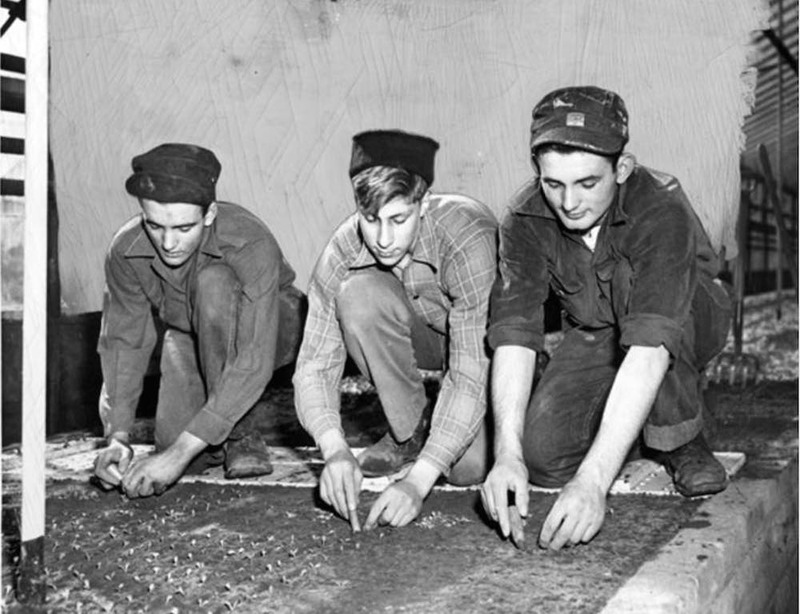
"An acre of lettuce under the artificial rain is a sight to remember. The sun plays rainbows on the mist and glints from the little pools and bright green leaves; the moisture stirs rich smells from the light earth; the rain itself, the patter of the drops on the leaves, the grateful odor of the plants and soil, all are in miniature, confined under a sky of glass—within is spring, beyond lies winter." — John W. Love, "Manufacturing Cleveland’s Vegetables," Cleveland Plain Dealer, February 4, 1923
On the southern rim of the industrial Flats along the Cuyahoga River, Martin Luther Ruetenik, son of a German immigrant pastor, built his first greenhouse on Schaaf Road in the village of Brooklyn Heights in 1885. Over time his greenhouses and truck farms earned him the nickname the “Celery King.” By 1900 a handful of other growers, including Fred Witthuhn, had joined him, placing a total of five acres “under glass.” Despite increasing competition from southern and western states, the Brooklyn Heights greenhouse industry continued to expand, and Ruetenik pioneered scientific methods that made Cleveland’s hothouse industry a national model. By the mid-1920s, some fifty businesses maintained eighty acres of greenhouses that grew primarily tomatoes, leaf lettuce, and cucumbers in rapid rotation. A secondary focus of the industry was to supply Easter lilies and “the potted plant and window box trade.”
Ruetenik and other growers banded together in 1926 to form the Cleveland Hothouse Vegetable Growers’ Cooperative Association. This organization undertook scientific research and promoted greenhouse produce. It also started the Greenhouse Vegetable Packing Company in Berea, which graded and packed tomatoes and other produce bound for market. Martin Reutenik maintained a fleet of Ford Model T’s that trucked produce to markets from Indiana to Pennsylvania. However, the majority of the vegetables grown in Cleveland-area greenhouses were sold locally from small roadside stands and in Central and West Side Markets.
Greenhouse agriculture was no simple endeavor. In fact, it was both laborious and expensive. In summer, when Ohio’s outdoor farms were in the middle of their growing season, greenhouse farmers were hard at work sterilizing soil, cleaning boilers, and repiping their greenhouses as needed. Sometimes they burned tobacco stems in large cans, releasing clouds of blue smoke to kill insects inside the greenhouses. In fall, hothouse workmen transplanted seeds twice, ultimately placing them at regular intervals in long rows. Mimicking the work of bees, they tapped tomato blossoms with electric vibrating rods every other day to force fruit to develop on the plants. Using steel pipes to release steam, hothouse growers carefully regulated the temperature inside the greenhouses to create ideal conditions for crop development. Every few years workers also had to sterilize the soil with steam “lest the slightest disease invade the indoor empire.”
Cleveland’s greenhouse industry continued to expand through the mid-20th century, reaching 400 acres under glass and employing 1,000 hothouse farmers, many of them Puerto Rican migrants, by the early 1960s. By that time greenhouses stretched for more than two miles along either side of Schaaf Road, and additional smaller concentrations could be found in Olmsted Falls, Rocky River, Columbia Station, Berea, Avon, Sheffield Lake, and Wooster. In 1966, Governor James A. Rhodes visited the A. G. Heinrichs Greenhouse on Schaaf Road to promote Ohio’s greenhouse industry. At a special luncheon there, he washed down nine large hothouse tomatoes and a cucumber and Bibb lettuce salad with a glass of tomato juice. Even as Rhodes was extolling the hothouse growers’ successes, the “Greenhouse Capital of America,” which produced 80 million pounds of tomatoes each year, was already on the cusp of decline.
Greenhouse agriculture was always a high-cost undertaking that depended on high yields per acre to generate a profit. A single acre under glass not only required misting plants from overhead pipes with 750,000 gallons of water per year, it also produced a hefty heating bill. As the cost of burning coal in boilers to heat greenhouses became prohibitive in the early 1960s, farmers turned to natural gas, but then the energy crisis of the early 1970s drove up the price of gas so much that many greenhouse owners could no longer afford to operate. Pollution from nearby factories in the Flats produced smog that only compounded the problems associated with Cleveland’s notoriously dark, cloudy winters. Sometimes heavy rains caused chemicals in the air to seep into the greenhouses, burning plants. Industrial expansion also placed a premium on spacious farmlands outside the city, and many struggling hothouse growers were eager to sell. One such farmer, Edwin Orth, sold all but three acres of his 60-acre Brooklyn Heights farm in 1969, including 16 greenhouses, which became part of a new industrial park. Growing competition from government-subsidized greenhouse companies in Canada further undercut Cleveland’s greenhouses.
By the 1980s, most of the large greenhouses in Brooklyn Heights were no more. Smaller ones remained, but they turned away from growing vegetables in favor of flowers, trees, shrubs, and seasonal plants such as poinsettias. Today one can still see the Ruetenik mansion, which the “Celery King” built in the 1930s on Schaaf Road. Nearby a small handful of remnant greenhouses operate to this day, offering a hint of Cleveland’s onetime national reputation as a center of “manufactured” vegetables.
Could Northeast Ohio recapture its position as the “Greenhouse Capital of America?” If the Cuyahoga Valley Greenhouse Growers Association, formed in 2009, has its way, it will do so using state-of-the-art sustainable greenhouse technologies. The Green City Growers Cooperative, opened in 2013 in Cleveland’s Central neighborhood, produces hydroponic Butterhead, Cleveland Crisp, and Green leaf lettuce in a 3-1/4-acre greenhouse that overlooks the RTA rapid transit line. As the nation’s largest urban food-production greenhouse, Green City Growers is not so much a sign that Cleveland is returning to its coal-fueled hothouse heyday as it is a suggestion that the Forest City might become a national leader in environmentally friendly urban agriculture.
Images










